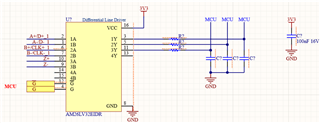Hi Experts,
Seeking assistance for designing the AM26LV32EIDR:
Seems there is no EVM for this part.
Is the schematic structure given in the picture below correct?

Following questions have been raised:
- Should I add the terminating resistor between lines A and B?
- Should I add it between the entire A and B line?
- What should be the value of the terminating resistor?
- What should be the R and C values in the schematic?
- Is there anything else I should add to the schematic?
Thank you.
Regards,
Archie A.


